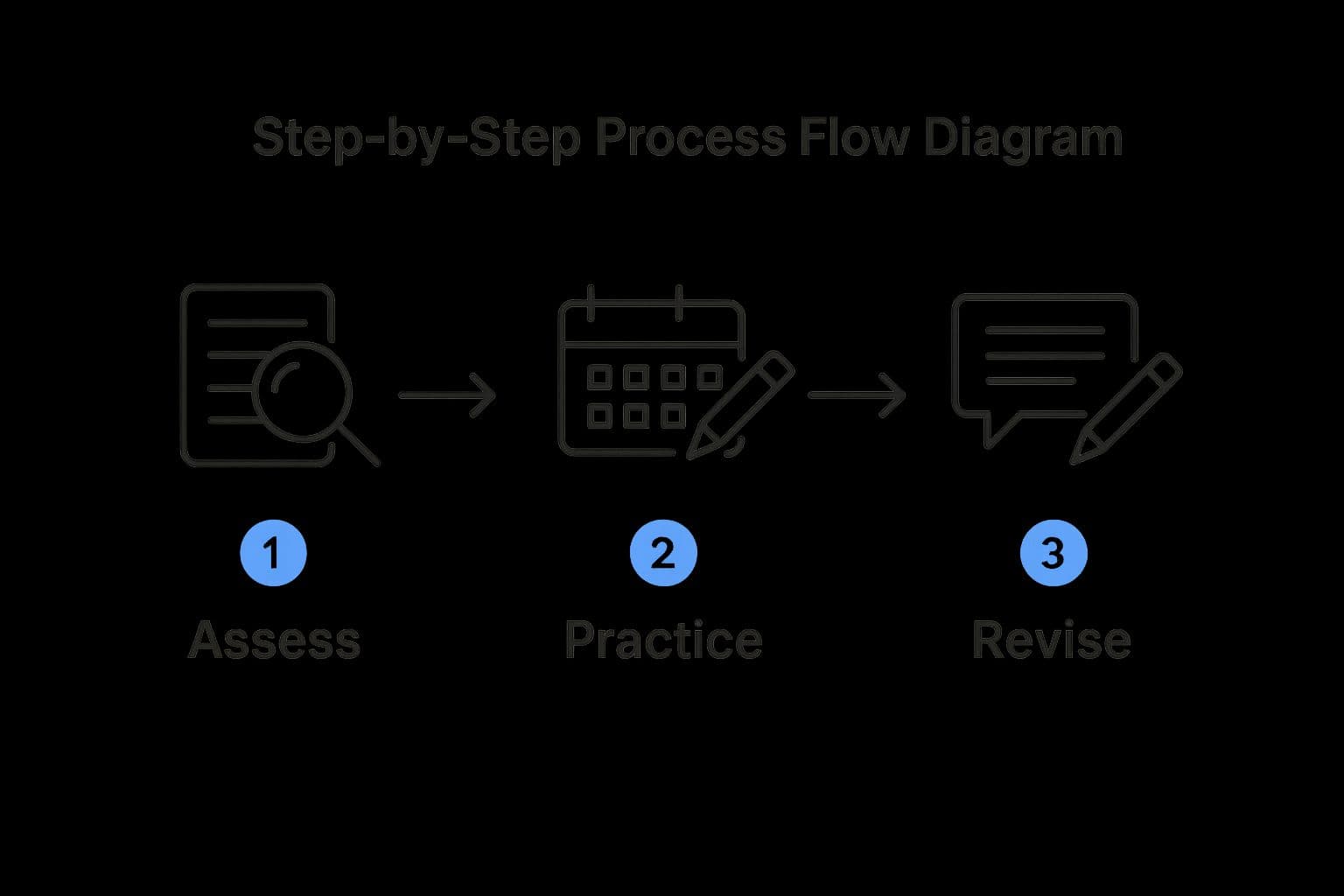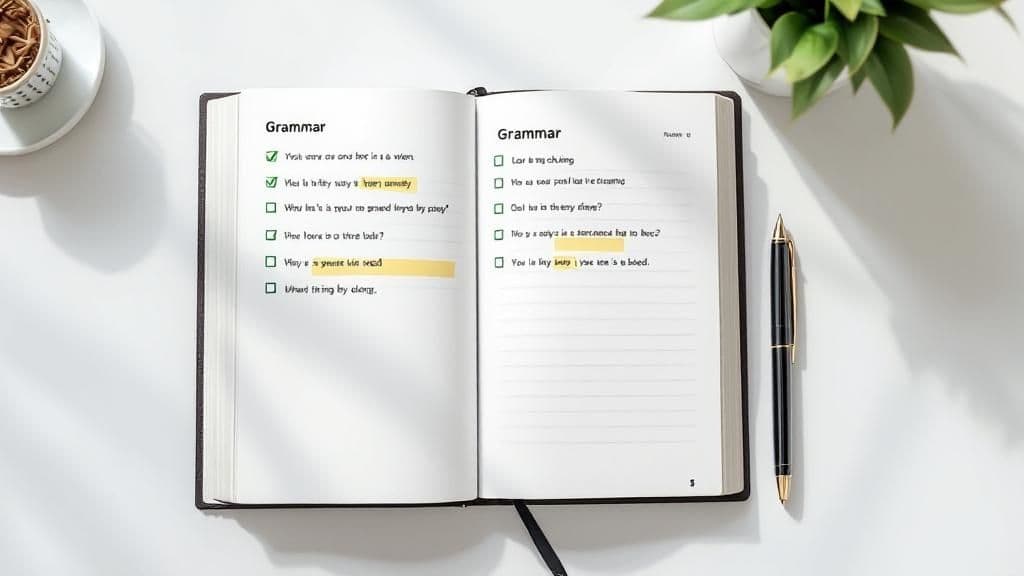Improve English Writing Skills The Practical Way
Want to improve English writing skills? This guide offers practical, real-world strategies and exercises to help you write with clarity and confidence.

Forget about diving headfirst into complicated grammar rules. The single best thing you can do to improve your English writing is to start a small, consistent daily habit. Seriously, just 10-15 minutes a day of easy, low-pressure writing is all it takes to build real momentum and confidence. Think of it as making writing a comfortable routine, not a scary test.
Build Your Writing Habit Without the Pressure
Let's be real—the biggest barrier to writing better isn't forgetting the difference between "your" and "you're." It's that paralyzing feeling of staring at a blank page. The trick is to create a safe space where you can just get your thoughts down on paper, judgment-free.
Don't even think about perfection at this stage. Your only goal is to build the muscle memory for writing in English. It's about consistency, not cramming. A quick daily session beats a long, once-a-week slog every single time.
Start a Simple Daily Journal
Your journal is your secret weapon. It’s a private playground to experiment with words and ideas without any pressure. You don't need profound prompts—just write about your day, rant about a movie you just saw, or map out your plans for the weekend. The simple act of turning your thoughts into written English is the entire workout.
The goal here isn't to create a literary masterpiece. It's to make writing as automatic as brewing your morning coffee. That consistency is what truly builds skill and confidence for the long haul.
And if you miss a day? Don't sweat it. Just jump back in the next day. The whole point is to make this an easy win, something you can feel good about doing.
Become an Active Reader
Writing and reading are two sides of the same coin. But instead of just passively consuming articles or books, start reading with a writer's mindset. When you find a piece of writing you love, pause and figure out why it works. Ask yourself a few questions:
- How did the author make that point so clearly?
- What specific words made this section feel exciting or emotional?
- How are they transitioning from one idea to the next so smoothly?
This kind of active reading is like getting a behind-the-scenes tour of good writing.

This 'Assess, Practice, Revise' loop you see here is the fundamental cycle for getting better at pretty much anything, especially writing. It’s a simple but powerful engine for real progress.
Your First Week English Writing Kickstart Plan
To help you get started, I've put together a super simple, one-week plan. It’s designed to be quick and easy, helping you build a solid foundation without feeling overwhelmed. Just follow along day by day.
| Day | Focus Activity (15-20 mins) | Goal |
|---|---|---|
| 1 | Write 3 sentences about your day. | Overcome the "blank page" fear and just get words down. |
| 2 | Describe an object near you in detail. | Practice using descriptive words (adjectives). |
| 3 | Write about a favorite memory. | Connect writing with positive emotions. |
| 4 | Explain a simple process (like making coffee). | Practice writing clear, sequential steps. |
| 5 | Find an interesting article and summarize it in one paragraph. | Work on active reading and summarizing skills. |
| 6 | Write about something you're looking forward to. | Practice future tense and expressing excitement. |
| 7 | Review your week's writing. Pick one entry and add more detail. | Introduce the idea of simple revision and self-editing. |
By the end of the week, you'll have established a tangible habit and proven to yourself that you can write in English every day.
The great news is that there's never been a better time to focus on these skills. Think about this: global literacy rates have jumped from a mere 10% in 1820 to around 90% today. That incredible progress, detailed by the team at Our World in Data, means more people than ever have the foundational ability to read and write, creating a perfect launchpad for anyone wanting to take their English skills to the next level.
Getting the Hang of Clear Writing Mechanics

Alright, so you're writing more consistently. That's a huge win. The next step is to start polishing what you're actually putting down on the page. We’re not aiming to sound like some stuffy academic journal here. The real goal is to make your writing so sharp and clear that your ideas hit the mark every single time.
Let go of that old fear of the red pen. Think of writing mechanics as the nuts and bolts you use to construct strong, readable sentences that people actually want to read.
A lot of people get bogged down thinking they need to memorize a dictionary-sized grammar book. The truth is, you don't need to be a grammar wizard to write well. You just need a solid grasp of the basics that keep your reader from getting confused.
Aim for Clarity, Not Complexity
Your number one job is to be clear. Can your reader understand your point without having to reread a sentence three times? One of the most common traps I see writers fall into is using overly complicated words and tangled sentences to try and sound "smarter." It almost always backfires.
When you're writing for an audience online—whether it's an email, a report, or a blog post—simplicity wins. Try writing like you're explaining something to a friend. This one mental shift can completely change how readable your work is. If you want to dig deeper into this, our guide on how to write professionally has some great tips on finding that perfect balance.
Tackling Those Common Grammar Goblins
Instead of trying to learn every rule under the sun, just focus on the common mistakes that trip most people up. Nailing these will give you the biggest bang for your buck and make your writing instantly better.
Here are a few of the usual suspects to keep an eye on:
- Comma Splices: This is just a fancy term for when you stick two complete thoughts together with only a comma.
- Instead of: I finished the report, it's ready for review.
- Try: I finished the report. It's ready for review. (Or even better: I finished the report, and it's ready for review.)
- Run-On Sentences: We’ve all done it. You get a great idea and just keep typing without any breaks, and suddenly you have one massive sentence. Chop those up into shorter, more digestible pieces.
- Subject-Verb Agreement: Make sure your subject and your verb are on the same team.
- Incorrect: The list of tasks are long.
- Correct: The list of tasks is long.
Don't think of these rules as handcuffs. They're more like the guardrails on a highway—they keep your reader moving smoothly toward your point without getting lost.
Let Tech Be Your Co-Pilot
Checking every single sentence for errors by hand is a drag. It’s tedious, and frankly, it kills your momentum. This is where a good tool can become your best friend in leveling up your English writing skills.
Think about it. You’ve just drafted a really important email to a client. Instead of agonizing over every comma, you could just use a tool like TypeBoost. Highlight your text, hit a quick shortcut, and tell it to "Fix grammar and spelling."
But the real magic isn't just the instant fix. It's the learning opportunity. When TypeBoost suggests a change, take a second to ask yourself, "Okay, why is that better?" Before you know it, you'll start spotting your own common mistakes and fixing them on the fly. It turns a simple editing tool into your own personal writing coach, helping you build real, lasting confidence.
Finding Your Voice and Expanding Your Vocabulary

Alright, once you've got the nuts and bolts of grammar and structure down, it's time for the fun part. This is where you graduate from simply writing clear sentences to crafting prose that has personality—your personality. Developing a unique writing voice and building a richer vocabulary are the steps that take your content from forgettable to memorable.
First, let's talk vocabulary. Forget those long, boring lists of words you’ll never actually use. The real secret is learning new words in context. The next time you're reading an article or a book and stumble upon a word you don't know, don't just glide past it. Look it up, sure, but pay close attention to how the author used it in that specific sentence.
This kind of active learning makes new words stick in a way flashcards never could. It forges a connection between the word and a real-world example, giving you a much better feel for its nuance and true meaning.
Go Beyond Basic Synonyms
A thesaurus is a great tool, but most people use it all wrong. They just find a synonym, plug it in, and call it a day. This usually leads to clunky, unnatural phrasing. The goal isn't just to find a different word; it's to find a better one.
For instance, instead of swapping "good" with "superb," really think about what you're trying to convey. Is the meal just tasty? Or is it a rich, flavorful, even decadent experience? Each word carries its own specific weight and emotional punch.
Your voice is the personality that shines through in your writing. It’s a mix of your word choice, sentence structure, and overall tone. The aim is to sound like an authentic human, not a robot trying to impress someone with big words.
Finding that voice requires a bit of experimentation. Try writing about the same topic in a few different styles. First, write it as a serious, formal explanation. Then, rewrite it like you're sending a casual message to a friend. Pay attention to the shifts in your word choice and sentence rhythm. This kind of practice makes you way more flexible and intentional with your tone.
Learn From the Writers You Admire
Honestly, one of the best ways to get better at writing is to dissect the work of writers you love. Just pick a short passage—a paragraph or two is plenty—and break down what makes it so good.
- Sentence Variation: Do they mix short, punchy sentences with longer, more descriptive ones? How does that create a nice rhythm?
- Word Choice: What specific verbs or adjectives pop off the page? Why did they pick that word over a more common one?
- Tone: How does the writing make you feel? Is it funny, serious, inspiring, or urgent? What choices did they make to create that feeling?
The point isn't to copy their style, but to understand the techniques they’re using. Think of it as adding new tools to your own writer's toolkit.
Here's a practical way to try this with a tool like TypeBoost. Highlight a paragraph of your own writing, open the tool, and give it a simple prompt like, "Rewrite this to sound more persuasive," or "Make this paragraph sound more confident." Comparing the before-and-after versions shows you how tiny tweaks in wording can completely change the tone and impact, helping you discover a voice that really clicks with your readers.
Using Feedback and Revision to Get Better Faster
Let's be honest, the real magic doesn't happen in the first draft. That initial flurry of getting ideas down is crucial, but your biggest breakthroughs will come from the rewrite. When you stop seeing editing as a chore and start viewing it as your secret weapon for improvement, everything changes. It's how you sharpen good ideas into truly great writing.
I've seen so many writers share their work, get a little criticism, and just deflate. The trick is to completely reframe what that feedback means. It's not a judgment on you or your talent; it's a personalized roadmap showing you exactly what to work on next. This simple mental shift turns criticism from a roadblock into rocket fuel.
Where to Find Feedback That Actually Helps
Getting reliable feedback is everything. Sure, asking a friend is easy, but they might not know what to look for, or worse, they might be too polite to tell you what you really need to hear. You need input that pushes you.
Here are a few places I've found genuinely useful feedback over the years:
- Peer Writing Groups: Communities on places like Reddit or other writing forums can be goldmines. Trading work with other writers gives you a ton of different perspectives you'd never get on your own.
- Mentors or Tutors: Nothing beats having a more experienced writer in your corner. They can spot the patterns in your mistakes that you're too close to see.
- Smart Online Tools: While it's not a person, an AI assistant like TypeBoost can be an amazing editing partner. It offers instant feedback on grammar, clarity, and tone, and it never gets tired of your drafts.
Here's the thing: effective feedback isn't just about catching typos. It’s about knowing if your message actually landed. Did the reader get your point? Was the tone right? Was it a breeze to read? That’s the good stuff.
This focus on how your writing performs can speed up your progress like crazy. In fact, a 2020 study showed that when this kind of assessment was used, it had a massive impact. A whopping 92.85% of students felt more interested in their writing, and 85.71% got a serious self-esteem boost. You can dive into the details in the full study on performance assessment if you're curious.
Your Practical Self-Editing Checklist
Before you even think about showing your work to someone else, you need to be your own toughest critic. Once you finish a draft, walk away. Go make a coffee, take a walk—anything. Coming back with fresh eyes is the best way to spot those clunky phrases and awkward sentences you were blind to before.
A simple trick that works wonders? Read your work out loud. I can't stress this enough. Your ears will catch all the stuff your eyes miss, like unnatural rhythms, repetitive words, and sentences that drag on forever. This is a core part of the process we break down in our guide on how to write faster and better without sacrificing quality.
When you're ready to revise, don't try to fix everything at once. Make several passes, each with a single mission:
- The Big Picture Pass: Is your main point crystal clear? Do the paragraphs flow logically from one to the next?
- The Word-Chopping Pass: Be ruthless. Can you say the same thing with fewer words? Hunt down and destroy filler like "really," "very," and "just."
- The Final Polish: This is your last check. Scan for typos, grammar slip-ups, and punctuation errors.
By making this cycle of writing, getting feedback, and revising with purpose a regular habit, you'll see your English writing skills improve faster than you ever thought possible.
Practical Exercises That Actually Work

It’s one thing to read about writing well; it’s another to actually do it. Let's get our hands dirty with some exercises that go beyond theory and build real, practical skills you can use every day.
These aren't your high school grammar drills. They're designed to build specific writing muscles—clarity, conciseness, and tone—so you can see a tangible improvement in your work.
Practice Brevity by Summarizing
Getting to the point is harder than it sounds. We all have a tendency to ramble, but concise writing is powerful writing. Here’s a simple exercise I love for tightening things up.
- Grab a news article or a blog post, something in the 500-800 word range.
- Read it through once or twice until you’ve got a solid grasp of the main idea.
- Now, here's the challenge: summarize the entire piece in exactly three sentences.
This exercise forces you to slash the fluff and zero in on what truly matters. It's tough, but it's an incredible workout for your "get to the point" muscle, a skill that pays off in everything from emails to executive summaries.
Master Clarity by Simplifying Complexity
Ever tried to explain a technical concept to a non-technical friend? It's a real test of your communication skills. The ability to make complex ideas simple is a superpower in the professional world.
For this exercise, find a dense piece of text. Think academic journals, legal documents, or a technical manual. Your mission is to rewrite one of those tangled paragraphs in plain, simple English. Pretend you're explaining it to a good friend over coffee.
This isn't just about swapping big words for small ones. It's about completely rethinking the structure and flow to make the information click. You're building a bridge from confusing to clear.
This is also a great place to bring in a tool like TypeBoost. Highlight the original complex text, hit your shortcut, and feed it a prompt like, "Rewrite this paragraph for someone who has never heard of this topic." You can then compare your version with the AI's, which is a fantastic way to discover new approaches to untangling tricky subjects.
Hone Your Tone by Crafting Persuasive Emails
The right tone can be the difference between getting a "yes" and getting ignored. How you say something is often just as important as what you're saying. A great way to practice this is by writing persuasive emails for different scenarios.
Let's try one out:
- Scenario: You need to ask a swamped colleague for help on a project, and the deadline is looming.
- Objective: Write an email that respects their time, clearly states your need, and makes them want to help—without coming off as demanding or desperate.
Pay close attention to your phrasing. Focus on words that show appreciation, acknowledge their workload, and hint at a mutual benefit. This kind of real-world practice does more than just improve your writing skills; it makes you a more effective and respected collaborator.
And if you want to tackle a bigger project that combines these skills, learning how to write an awesome blog post is a fantastic next step.
Got Questions About English Writing? Let's Answer Them
As you start putting these writing habits into practice, you're bound to have some questions. It’s totally normal to wonder if you’re doing things right or if you’re making progress. Let’s get some of the most common ones out of the way.
Getting clear on these points can make all the difference in keeping you motivated and moving forward. Think of it as a quick FAQ to help you sidestep common hurdles on your journey to becoming a better writer.
How Long Does It Really Take to See Improvement?
This is probably the number one question on everyone's mind. The honest answer? It's different for everyone. Your starting point, how often you practice, and the methods you use all play a huge role.
That said, if you commit to practicing for 30-60 minutes a day—really focusing on things like journaling and the exercises we've talked about—most people start to see real, noticeable changes in their clarity and confidence within 3 to 6 months. The secret sauce isn't cramming for hours, but consistency. A little bit of focused effort every single day builds momentum much faster than you’d expect.
The single most effective habit for better writing is this: write and read every single day. Reading stocks your brain with good examples, and writing forces you to put what you're learning into practice. It creates a powerful learning cycle that accelerates your progress more than anything else.
This daily routine builds the skills that matter. While the majority of the world can read and write, developing strong, effective communication skills is a different ballgame. It’s a challenge many face; UNESCO reports that while global literacy is over 86%, countless people still need to build the foundational skills necessary for today's world.
Can AI Writing Tools Actually Help Me Learn?
They absolutely can, but it all depends on how you use them. If you just hit "accept" on every suggestion without thinking, you're not learning—you're just using a crutch.
The trick is to use AI as a learning partner, not a magic fix. Here's how to do it right:
- Look for patterns: Do you see the same correction over and over? That’s a weak spot you can target for improvement.
- Deconstruct the grammar: Instead of just accepting a change, ask yourself why the AI suggested it. This helps you internalize the rules.
- Explore new phrasing: Use the suggestions as a way to see different ways of saying the same thing. This is great for expanding your stylistic range.
When you use it this way, an AI tool becomes your personal, on-demand writing tutor, helping you spot your weaknesses and actively improve them.
Ready to make your AI work for you? With TypeBoost, you can apply your own custom writing prompts to any text, right on your Mac. No more tedious copy-pasting. It’s time to start improving your writing right where you work. Give TypeBoost a try and see how it fits into your daily routine.